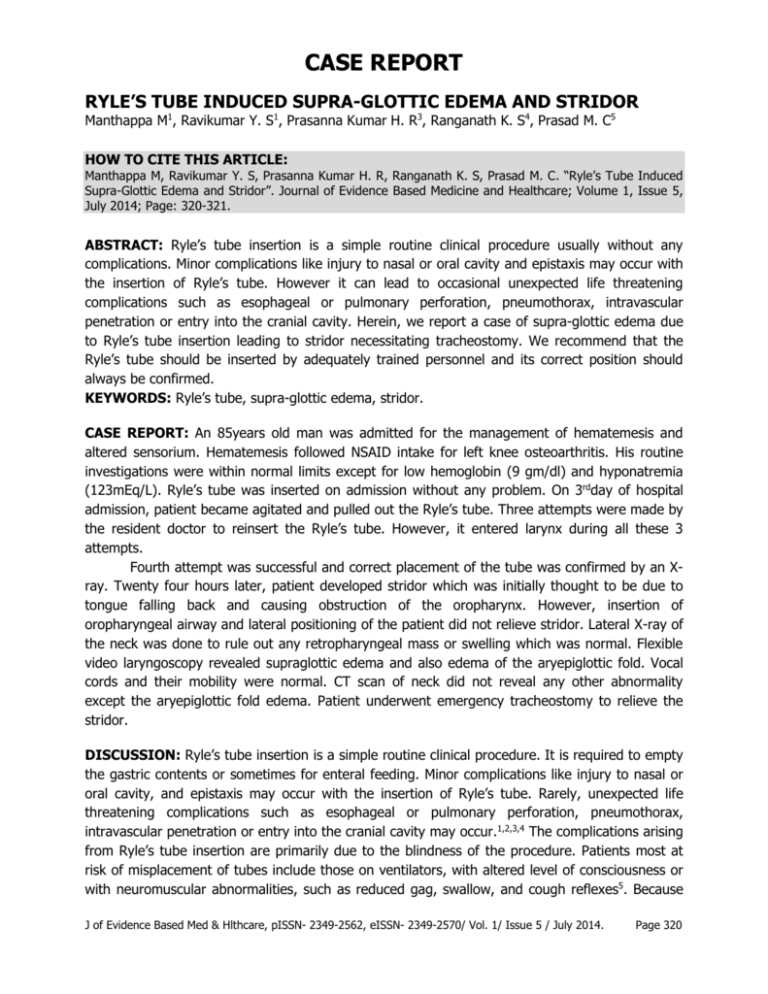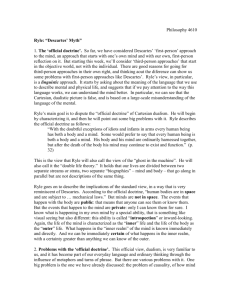ryle`s tube induced supra-glottic edema and stridor
advertisement

CASE REPORT RYLE’S TUBE INDUCED SUPRA-GLOTTIC EDEMA AND STRIDOR Manthappa M1, Ravikumar Y. S1, Prasanna Kumar H. R3, Ranganath K. S4, Prasad M. C5 HOW TO CITE THIS ARTICLE: Manthappa M, Ravikumar Y. S, Prasanna Kumar H. R, Ranganath K. S, Prasad M. C. “Ryle’s Tube Induced Supra-Glottic Edema and Stridor”. Journal of Evidence Based Medicine and Healthcare; Volume 1, Issue 5, July 2014; Page: 320-321. ABSTRACT: Ryle’s tube insertion is a simple routine clinical procedure usually without any complications. Minor complications like injury to nasal or oral cavity and epistaxis may occur with the insertion of Ryle’s tube. However it can lead to occasional unexpected life threatening complications such as esophageal or pulmonary perforation, pneumothorax, intravascular penetration or entry into the cranial cavity. Herein, we report a case of supra-glottic edema due to Ryle’s tube insertion leading to stridor necessitating tracheostomy. We recommend that the Ryle’s tube should be inserted by adequately trained personnel and its correct position should always be confirmed. KEYWORDS: Ryle’s tube, supra-glottic edema, stridor. CASE REPORT: An 85years old man was admitted for the management of hematemesis and altered sensorium. Hematemesis followed NSAID intake for left knee osteoarthritis. His routine investigations were within normal limits except for low hemoglobin (9 gm/dl) and hyponatremia (123mEq/L). Ryle’s tube was inserted on admission without any problem. On 3rdday of hospital admission, patient became agitated and pulled out the Ryle’s tube. Three attempts were made by the resident doctor to reinsert the Ryle’s tube. However, it entered larynx during all these 3 attempts. Fourth attempt was successful and correct placement of the tube was confirmed by an Xray. Twenty four hours later, patient developed stridor which was initially thought to be due to tongue falling back and causing obstruction of the oropharynx. However, insertion of oropharyngeal airway and lateral positioning of the patient did not relieve stridor. Lateral X-ray of the neck was done to rule out any retropharyngeal mass or swelling which was normal. Flexible video laryngoscopy revealed supraglottic edema and also edema of the aryepiglottic fold. Vocal cords and their mobility were normal. CT scan of neck did not reveal any other abnormality except the aryepiglottic fold edema. Patient underwent emergency tracheostomy to relieve the stridor. DISCUSSION: Ryle’s tube insertion is a simple routine clinical procedure. It is required to empty the gastric contents or sometimes for enteral feeding. Minor complications like injury to nasal or oral cavity, and epistaxis may occur with the insertion of Ryle’s tube. Rarely, unexpected life threatening complications such as esophageal or pulmonary perforation, pneumothorax, intravascular penetration or entry into the cranial cavity may occur.1,2,3,4 The complications arising from Ryle’s tube insertion are primarily due to the blindness of the procedure. Patients most at risk of misplacement of tubes include those on ventilators, with altered level of consciousness or with neuromuscular abnormalities, such as reduced gag, swallow, and cough reflexes5. Because J of Evidence Based Med & Hlthcare, pISSN- 2349-2562, eISSN- 2349-2570/ Vol. 1/ Issue 5 / July 2014. Page 320 CASE REPORT of all these possible complications, it is imperative to check the correct position of the distal end of the tube before using it. Our patient had altered level of consciousness due to hyponatremia. During three unsuccessful attempts of Ryle’s tube insertion, tube entered into larynx and traumatized the supra-glottic area leading to edema formation and stridor. There are no previous such reports of supra-glottic edema due to Ryle’s tube insertion leading to stridor. CONCLUSION: Though, Ryle’s tube insertion is a simple routine procedure, it can lead to occasional life threatening complications. Hence, it should be inserted by adequately trained personnel and its correct position should always be confirmed. Supra-glottic edema which we report here can also be one of the life threatening complications. REFERENCES: 1. Weinberg L, Skewes D. Pneumothorax from intrapleural placement of a nasogastric tube. Anaesth Intensive Care 2006-Apr; (34-2): 276-9. 2. AK Pandey, AK Sharma, BD Diyora, PP Sayal, HA Ingale, M Radhakrishnan. Inadvertent insertion of nasogastric tube into the brain. JAPI April 2004: 52; 322-23. 3. James RH. An unusual complication of passing a narrow bore nasogastric tube. Anaesthesia 1978; 33: 716–18. 4. Iyer VS, Reichel J. Perforation of the esophagus by a fine feeding tube. N Y State J Med 1984; 84: 63–4. 5. Olivares L, Segovia A, Revelta R. Tube feeding and lethal aspiration in neurological patients: a review of 720 autopsy cases. Stroke 1974; 5: 654–7. AUTHORS: 1. Manthappa M. 2. Ravikumar Y. S. 3. Prasanna Kumar H. R. 4. Ranganath K. S. 5. Prasad M. C. PARTICULARS OF CONTRIBUTORS: 1. Associate Professor, Department of Medicine, J.S.S. Medical College, J.S.S. University, Mysore. 2. Professor, Department of Medicine, J.S.S. Medical College, J.S.S. University, Mysore. 3. Assistant Professor, Department of Medicine, J. S. S. Medical College, J. S. S. University, Mysore. 4. Senior Resident, Department of Medicine, J. S. S. Medical College, J. S. S. University, Mysore. 5. Senior Resident, Department of Medicine, J. S. S. Medical College, J. S. S. University, Mysore. NAME ADDRESS EMAIL ID OF THE CORRESPONDING AUTHOR: Dr. Manthappa M, Associate Professor, Department of Medicine, J. S. S. Medical College, J. S. S. University, Mysore – 575002. E-mail: manthappa@yahoo.com Date Date Date Date of of of of Submission: 19/07/2014. Peer Review: 23/07/2014. Acceptance: 25/07/2014. Publishing: 31/07/2014. J of Evidence Based Med & Hlthcare, pISSN- 2349-2562, eISSN- 2349-2570/ Vol. 1/ Issue 5 / July 2014. Page 321







